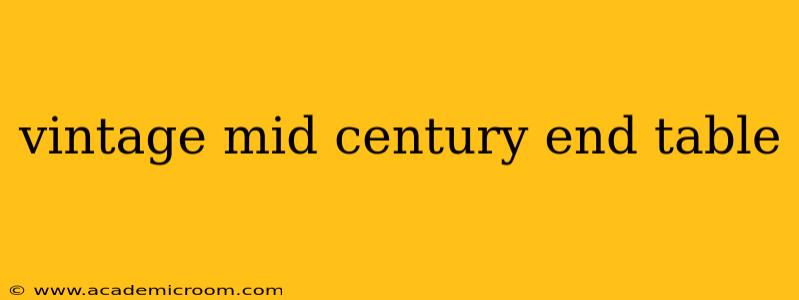The allure of a vintage mid-century modern end table is undeniable. These pieces, often crafted from sleek materials and boasting simple yet elegant designs, add a touch of timeless sophistication to any room. But navigating the world of vintage furniture can be tricky. This guide will help you understand what makes a mid-century end table special, how to identify authentic pieces, and what to look for when buying one.
What Defines a Mid-Century Modern End Table?
Mid-century modern design, flourishing roughly from the 1930s to the 1960s, is characterized by clean lines, functionality, and the use of innovative materials. End tables from this era often reflect these principles. Key features to look for include:
- Simple, geometric shapes: Avoid overly ornate designs. Think tapered legs, minimalist silhouettes, and straightforward forms.
- Natural materials: Wood, especially teak, walnut, and rosewood, was a popular choice. You might also find examples using metal, laminate, or even glass.
- Functionality: Mid-century pieces prioritize usability. Look for end tables with practical features, such as drawers, shelves, or a spacious tabletop.
- Organic forms: While geometric, some pieces incorporated organic curves, softening the overall aesthetic.
How to Identify Authentic Vintage Mid-Century End Tables?
Determining authenticity can be challenging, as many reproductions exist. Here are some tips:
- Examine the craftsmanship: Authentic pieces often exhibit superior craftsmanship, with meticulous joinery and attention to detail. Look for signs of hand-finishing, slight imperfections that add to the charm, not flaws that indicate poor quality.
- Check the materials: Pay close attention to the type of wood and its quality. Real wood will have unique grain patterns and may show signs of age. Look for maker's marks or labels.
- Research the maker: Many renowned designers and manufacturers produced mid-century furniture. Researching known makers can help you verify the authenticity and potentially increase the value of your find.
- Look for age-related wear: While not always present, genuine vintage pieces may show signs of age, such as minor scratches, discoloration, or wear on the finish. This is often a positive indicator of authenticity.
What are some popular mid-century modern end table styles?
The variety of mid-century modern end tables is astounding. Popular styles include:
- Danish Modern: Known for its organic shapes and simple elegance, often utilizing teak or rosewood.
- American Modern: Characterized by sleek lines, functionality, and a more streamlined aesthetic.
- Atomic Ranch: Incorporating bolder shapes and playful elements, often with a more vibrant color palette.
What should I look for when buying a vintage mid-century end table?
Purchasing a vintage piece requires careful consideration. Here's what to look for:
- Condition: Assess the overall condition of the end table, checking for any damage, loose joints, or structural issues. Consider whether restoration is necessary and feasible.
- Price: Research comparable pieces to ensure you're paying a fair price. Consider the maker, materials, and condition when determining value.
- Size and scale: Measure your space to ensure the end table is appropriately sized for your room.
- Style and aesthetic: Choose a piece that complements your existing décor and personal style.
Are mid-century end tables a good investment?
Yes, many mid-century modern furniture pieces, including end tables, appreciate in value over time, particularly those by well-known designers or manufacturers in excellent condition. However, it's crucial to purchase authentic pieces and carefully consider the condition and market value before making a purchase.
Where can I find vintage mid-century end tables?
You can find vintage mid-century end tables at a variety of places, including:
- Antique shops and flea markets: These locations often offer a wide selection of vintage furniture at varying price points.
- Online marketplaces: Websites such as eBay and Etsy offer a vast inventory of vintage furniture. Be sure to carefully examine photos and read seller descriptions.
- Estate sales: Estate sales are a great source for finding unique vintage pieces, sometimes at bargain prices.
- Consignment shops: These shops specialize in selling previously owned furniture, often offering a curated selection of high-quality pieces.
How do I care for my vintage mid-century end table?
Proper care will help preserve your vintage end table for years to come. Consider:
- Regular dusting: Use a soft cloth to regularly dust your end table, preventing the accumulation of dirt and debris.
- Protect from direct sunlight: Direct sunlight can cause fading and damage to the finish.
- Use coasters and placemats: Protect the surface of your end table from scratches and watermarks by using coasters and placemats.
- Avoid harsh chemicals: Never use harsh chemicals or abrasive cleaners on your vintage end table.
By following these tips and taking your time to find the perfect piece, you can acquire a beautiful and valuable vintage mid-century modern end table that will enhance your home for years to come. Remember, the hunt is half the fun!
